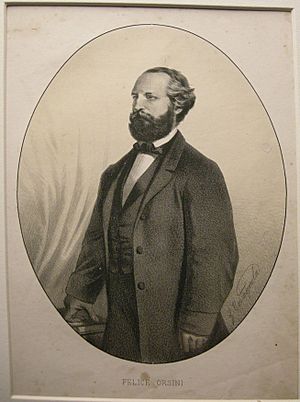Felice Orsini facts for kids
Quick facts for kids
Felice Orsini
|
|
|---|---|
| Born |
Felice Orsini
10 December 1819 |
| Died | 13 March 1858 (aged 38) |
Felice Orsini (born December 10, 1819 – died March 13, 1858) was an Italian revolutionary. A revolutionary is someone who wants to bring about big changes in society or government. Orsini was a leader of a secret society called the Carbonari. He is most known for trying to assassinate Napoleon III, who was the Emperor of France.
Contents
Early Life and Beliefs
Felice Orsini was born in a town called Meldola. This area, known as Romagna, was then part of the Papal States. The Papal States were lands in Italy ruled by the Pope.
Orsini was first encouraged to become a priest. However, he chose a different path. He became a strong believer in freedom and new ideas. He joined a political group called Giovane Italia (Young Italy). This group was founded by Giuseppe Mazzini and worked to unite Italy.
Fighting for Change
In 1844, Orsini was arrested with his father. They were involved in plans for change and were sent to prison for a long time. But the new Pope, Pius IX, later set him free.
After his release, Orsini led a group of young men from Romagna. They fought in the First War of Italian Independence in 1848. He showed great bravery in battles at Treviso and Vicenza.
In 1849, Orsini was chosen to be a member of the Roman Constituent Assembly. This was a group that helped govern the revolutionary republic in Rome. After this republic fell, he continued to work against the Pope's rule. He was still part of Mazzini's group.
Escape from Prison
Mazzini sent Orsini on a secret mission to Hungary. But in 1854, Orsini was arrested again and put in prison in Mantua. A few months later, he made an amazing escape! He used a tiny saw to cut through two metal bars. Then, he climbed out of a window that was 100 feet (about 30 meters) above the ground. He slid down using a rope he had made from bedsheets. He pretended to be a simple farmer and managed to get past the Austrian guards.
Planning the Assassination
After his escape, Orsini visited Great Britain in 1856. People were interested in his story, and a newspaper published his tale of escape. He also published his own book, The Memoirs and Adventures of Felice Orsini, in 1856. In 1857, he wrote another book about his time in prison called The Austrian Dungeons in Italy.
Orsini became convinced that Napoleon III was stopping Italy from becoming independent. He believed Napoleon III was also causing problems for freedom across Europe. So, Orsini decided to plan Napoleon III's assassination. He thought that if the emperor died, France would have a revolt. He hoped Italians could then use this chance to start their own revolt.
In late 1857, Orsini went back to England. He asked a gunsmith named Joseph Taylor to make six special bombs. These bombs were designed by Orsini himself to explode when they hit something. He tested the bombs in England with the help of another radical, Simon Bernard. Once he was happy with them, Orsini returned to Paris with the bombs. He met with other people who were part of his plan, including Giuseppe Pieri, Antonio Gomez, and Carlo di Rudio (who later became Charles DeRudio).
Attempt on Napoleon III's Life
On the evening of January 14, 1858, Emperor Napoleon III and Empress Eugénie were going to the theatre in Paris. Orsini and his friends threw three bombs at their carriage.
The first bomb landed near the horsemen in front of the carriage. The second bomb hurt the horses and broke the carriage windows. The third bomb exploded under the carriage. It seriously wounded a policeman who was trying to protect the Emperor and Empress. Eight people were killed and 142 were wounded. Luckily, the Emperor and Empress were not hurt. They bravely decided to continue to the theatre and appear before the public.
Orsini himself was wounded on his head and was confused. He treated his wounds and went back to his room. The police found him there the next day. This assassination attempt actually made Napoleon III more popular.
Orsini's Letter and Judgment
On February 11, Orsini wrote a famous letter to Napoleon III. In the letter, he urged the Emperor to support Italy's independence. Interestingly, some historians think Napoleon III might have even helped write parts of this letter himself. Orsini also wrote another letter to the young people of Italy, saying that political assassination was wrong.
Orsini was sentenced to death. He calmly went to the guillotine, a machine used for executions, on March 13, 1858. His friend Pieri was also executed. Gomez was sentenced to hard labor for life. Di Rudio was sentenced to death, but his sentence was changed to life in prison on Devil's Island. He later escaped from there and went to America. He became an officer in the United States Army and fought in the 1876 Battle of the Little Big Horn, which he survived.
See also
 In Spanish: Felice Orsini para niños
In Spanish: Felice Orsini para niños



